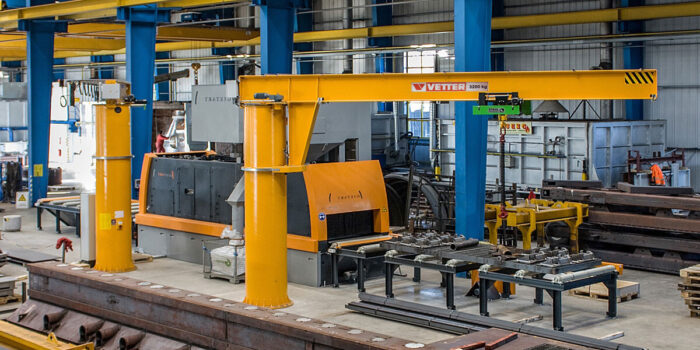Training as maintenance and stationary crane operator
Stationary cranes, also known as cranes, are cranes consisting of columns and booms. The courses we offer teach the operation of high-tech equipment, extremely useful in a wide variety of industries.
What is the course like?
Training for stationary crane operators and maintainers prepares participants both practically and theoretically. Our programme includes, for example:
- requirements of inspection services,
- machine types and specifications,
- ways of ensuring safe working conditions,
- both hydraulic and electrical subsystems,
- preparing the crane for operation,
- capacity issues,
- the daily challenges of operating a crane.
We teach practical skills on capable equipment, on specially designed manoeuvring areas.

Licensing examination
Training as a stationary crane operator and maintainer concludes with the relevant state examination conducted by the Office of Technical Inspection. The exam, like the course, is divided into a theoretical and a practical part. Both are designed to test the skills acquired with regard to a specific piece of equipment and its operation. All the lessons included in our training should fully prepare you for the exam.
Location
We organise training courses throughout Poland, including Warsaw, Krakow, Katowice, Lublin, Gdansk, Poznan and Szczecin. We also offer the option of classes with travel to the client. The course can take the form of:
- closed,
- open.
Other aspects, such as deadlines, depend on the interest in a particular course.
Our requirements
All candidates for the course must have:
- 18 years,
- lack of contraindications to exercise the profession on the basis of a medical certificate,
- primary or higher education.
Training objectives
Our trainees must be competent in operating all types of stationary cranes and be ready to work in a variety of conditions. They must also be familiar with the technical data of the different types of cranes and be able to detect faults and use them safely.
Applications for stationary cranes
- for transporting loads as a handling device,
- in production processes and their optimisation,
- for unloading work,
- for assembly work,
- for renovation work.
Lifting units
- electric rope hoist,
- pneumatic hoist,
- chain hoist.
Design of stationary cranes
The main division of cranes distinguishes between wall-mounted and pillar-mounted cranes, but the most important design feature is their base or, in other words, their method of attachment. Depending on the type, the crane can be fixed to the machine or to the ceiling. It can also be mounted on a so-called footing or intermediate plate.
Motor mechanisms

The rotation of the crane is usually carried out by:
- mechanically or electrically driven rotation,
- manual rotation.
Electric rotation usually uses a friction coupling or a toothed ring.
Arm
Cranes can have one or two booms. They are either mounted opposite each other or one on top of the other. Among industrial cranes, you will most often find cranes with a bent arm, as this is the best way to utilise their capabilities in confined spaces.
Selection of stationary cranes
When choosing the right model of stationary crane, it is important to bear in mind its most important technical parameters. These are:
- load capacity,
- angle of rotation,
- lifting height,
- overhang.
Another important thing to consider is the so-called operating speeds. There is a distinction between lifting speed, hoist travel speed and slewing speed.
Other types of cranes
Stationary cranes are not the only type of this equipment. In addition to these, we also distinguish between:
- mobile cranes,
- mobile cranes,
- rail-mounted cranes,
- tower cranes,
- railway cranes,
- deck cranes,
- floating cranes.
Why use stationary cranes?
Cranes perfectly support the work of any industrial enterprise. They are one of the best solutions among handling equipment. They are perfect for places that are difficult to access, e.g. when transporting loads at heights. They are also much more stable than other types of cranes.
Questions and answers
Why work with stationary cranes?
Stationary cranes are the best option for use mainly in industrial halls. They are characterised by a high lifting capacity and much better stability than other types. They are therefore frequently used, so the demand for operators is also high.
What formalities apply to stationary cranes?
Stationary cranes belong to the group of equipment subject to the Technical Inspection Authority. This means that they must be registered and subjected to regular inspections. An appropriate licence is required to operate them.
What other types of cranes are there?
In addition to stationary cranes, a distinction is made between mobile and portable, mobile, rail, rail, deck, floating and tower cranes.


